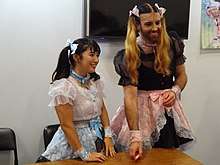Kawaii metal
Kawaii metal (also known as idol metal,[1] cute metal, or kawaiicore[2]) is a musical genre that blends elements of heavy metal and J-pop that was pioneered in Japan in the early 2010s. A typical kawaii metal composition combines the instrumentation found in various types of heavy metal music with J-pop melodies and a Japanese idol aesthetic. Kawaii metal's lyrical topics are often less hostile than those of other heavy metal genres.
| Kawaii metal | |
|---|---|
| Etymology | Kawaii |
| Other names |
|
| Stylistic origins | |
| Cultural origins | Early 2010s, Japan |
| Typical instruments | |
| Other topics | |
The Japanese girl group Babymetal is often credited with the creation and success of kawaii metal. In addition to Babymetal, kawaii metal acts such as Ladybaby have garnered media attention, as well as minor commercial attention, for performing songs of this genre.
History and characteristics
.jpg)
Japanese heavy metal idol group Babymetal are considered the inventors of the kawaii metal genre.[3][4] Angelica Wallingford of City Times opined that Babymetal's eponymous debut album had pioneered the kawaii metal musical genre. Wallingford also defined the genre, and album, as a "mixture of varying genres including pop, rock, heavy metal, electronic dance music, industrial and symphonic death metal".[5] A guest contributor at The Independent believed that the genre was a derivative of J-pop and various extreme metal genres, namely "speed metal, power metal, black metal, and industrial metal".[6] While discussing Babymetal, The Sydney Morning Herald's Rob Nash opined that the genre consisted of "sugary pop melodies over thrash metal": Nash also believed that the group's song, "Awadama Fever" exemplified the genre, saying the song contained "slabs of angry guitar and undanceably fast breakbeats, while the girls [Babymetal] squeak about 'bubble ball fever' and chewing gum".[7]

Discussing Ladybeard, and Ladybaby, Jake Cleland of The Sydney Morning Herald defined the genre as "saccharine pop with his heavy metal growling".[8] Alex Weiss of Paper defined the genre as "hard rock with sugary sweet pop hooks". Weiss also used Babymetal's songs "Karate" and "Road of Resistance" as examples to explain the differing lyrical perspective between the kawaii metal and other metal genres, stating that kawaii metal songs "offer a perspective often missing from the hyper-masculine, aggressive lyrics usually present in most of the [metal] genre's hits".[9] Felix Clay of Cracked.com also believed that the genre had less aggressive lyricism, citing the genre had lyrics about "pop music topics like kittens, chocolate, and fun".[1]
See also
References
- Clay, Felix (27 May 2016). "7 Strange Aspects Of Japan's Pop Idol Metal Music Scene". Cracked.com. Retrieved 16 October 2016.
- Ohanesian, Liz (15 October 2015). "Meet Ladybaby, Japan's Kawaiicore (and Pro-Wrestling) Answer to Andrew WK". Noisey. Retrieved 18 October 2016.
- "Nothing Personal: Babymetal Don't Like Answering Questions". Noisey. 15 July 2014. Retrieved 23 October 2016.
- Cleek, Taylor (17 July 2015). "The Unpredictable Rise of Kawaiicore". Beyond the Stage. Retrieved 28 October 2016.
- Wallingford, Angelica (27 March 2014). "'Kawaii' metal goes viral". City Times. Retrieved 17 October 2016.
- "Album Review: Babymetal's "Metal Resistance" is a Japanese metal mutant". The Independent. 21 May 2016. Retrieved 28 October 2016.
- Nash, Rob (11 June 2016). "Babymetal: Japan's heavy metal girl-band sensation". The Sydney Morning Herald. Retrieved 28 October 2016.
- Cleland, Jake (11 July 2015). "From Ladybeard to Ladybaby: the pro wrestling heavy metal singer taking Japan by storm". The Sydney Morning Herald. Retrieved 17 October 2016.
- Weiss, Alex (13 July 2016). "MEET THE JAPANESE GIRL GROUP GIVING METAL A KAWAII MAKEOVER". Paper. Retrieved 21 October 2016.